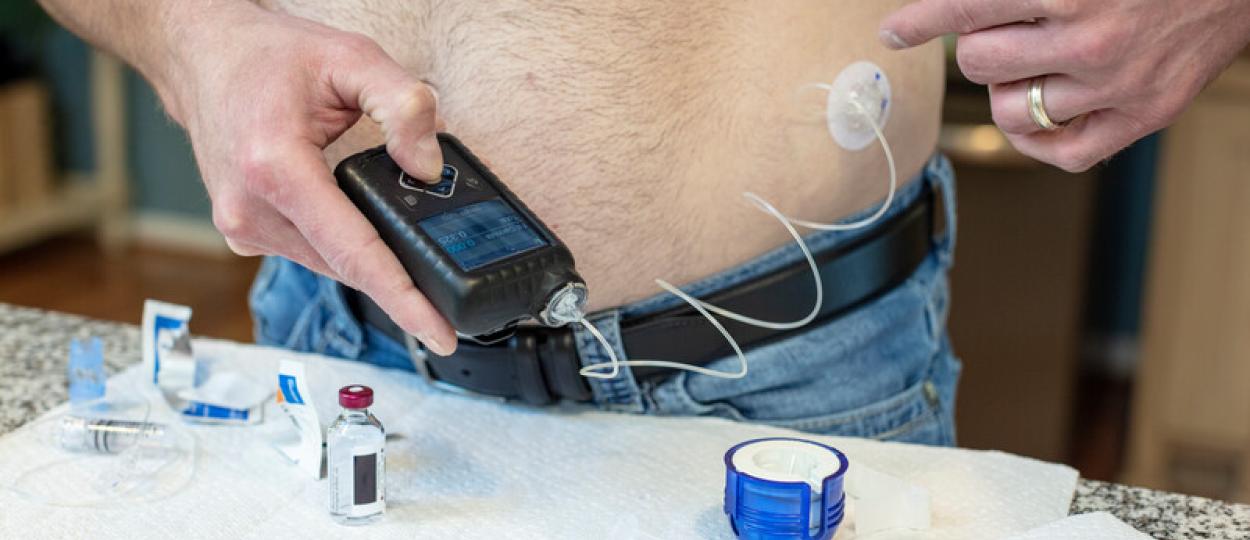The goal for managing CFRD is to keep your blood sugar at normal or near-normal levels, and to maintain good nutrition. Because insulin helps to build muscle tissue in the body, maintaining normal blood sugar levels will help you gain weight, develop and maintain muscle mass, feel better, and have more energy. Effective management of blood glucose levels also lowers the risk of problems caused by diabetes.
CFRD can be well managed with:
- Insulin
- Monitoring of your blood sugar levels
- A healthy, balanced diet as recommended by your CF and diabetes care teams
- Staying active
”Many people with CFRD are unsure about what to eat to manage their blood sugar levels. Fortunately, certain meal planning techniques can help.” — Gretchen Garlow, MS, RD, LDN, a CF dietitian, from the CF Community Blog
Many tools are available to help you monitor blood sugar levels, including blood glucose meters and continuous glucose monitors (CGMs). A blood glucose meter is used with test strips and lancets. You use the lancet to get a small amount of blood from your finger, and then place the blood on a test strip. You then insert the test strip into the meter where your blood glucose level is reported on a screen. A CGM is a device you wear on your body. It tests your glucose levels every 5 minutes and stores the information . CGM downloads provide data to help with management of CFRD. You can discuss using a CGM with your CF and diabetes care teams.
“Once I tried the CGM, I was hooked. I have been using it for almost two years and I absolutely love it.” — Tiffany Rich, adult with CF, from the CF Community Blog.
There are many types of insulin. They are grouped by how fast they work and how long they last in your body. You inject insulin into your body, and it helps your cells absorb the energy (calories) from the food you eat. Calories in food come from carbohydrates, protein, and fat. Insulin helps your cells absorb these three nutrients so that you can achieve and maintain a healthy weight and good nutritional status. To maintain normal blood glucose levels, people with CFRD are often asked to count the carbohydrates they eat, which helps to guide insulin therapy.
Insulin can be given multiple times per day via shots or via an insulin pump, which is a device that you wear on your body and fill with insulin. The pump will administer insulin to you continuously. The type and amount of insulin you get will vary. This treatment plan needs to be discussed with your CF and diabetes care teams.
Other diabetes drugs normally used for type 2 diabetes are rarely used in CFRD. There are some patients, however, that may benefit from noninsulin treatments. This is something you need to discuss with your CF and diabetes care teams.
What You Eat Is Important
The six major food groups contain different nutrients: carbohydrates, protein, fat, vitamins, minerals, and water. Foods that contain carbohydrates affect blood sugar the most because the body turns them into sugar. You may need to count the carbohydrates in your foods so you know how much insulin to take.
People with CF often have different nutrition needs, and each person's needs may differ. The use of CFTR modulator therapy has improved the overall health of many people with CF, and some people have found that they have gained unwanted weight by following a traditional CF diet that is high in calories, fat, and salt. Your diabetes care team can help you determine the eating plan that is right for you as well as the amount of insulin you need. The goal for good health is to achieve and maintain a healthy body weight.
Physical activity like exercise can help you improve your body's response to insulin. People with CFRD can exercise safely and are encouraged to do at least 150 minutes of some type of moderate aerobic exercise every week. Aerobic exercise includes activities that require you to breathe in oxygen, like jogging or playing sports. Because muscles use sugar for energy, exercise can cause blood sugar levels to drop. Check your blood sugar levels more frequently when exercising. Since each person reacts differently to exercise, it is important to work with your CF and diabetes care teams to tailor insulin needs to your exercise.
”If you have CFRD, be sure to check your blood sugar before and after exercise.” — Lee Degiorgio, an adult with CF, from the CF Community Blog
The Emotional Impact of Finding Out You Have CFRD
A CFRD diagnosis can have negative emotional effects. Many people with CF express frustration at having another long-term condition that takes time and effort to manage.
”CF already consumes so much of our daily lives. Do we really need to add blood sugar management on top of it all?” — Megan LePore, an adult with CF, from the CF Community Blog.
Coping with a new diagnosis like this can be difficult, but discussing it with your CF or diabetes care team may help. You may also find help through CF Peer Connect. CF Peer Connect is a one-to-one peer support program for people with cystic fibrosis and their family members age 16 and older. You can talk with and learn from someone who has gone through similar experiences.
Help From Your Care Team
If you are diagnosed with CFRD, your CF care team will need to include an endocrinologist (a doctor with special training in the treatment of diabetes) and certified diabetes educators. Working with you, this team will design a plan to help you manage your diabetes while also maintaining your health with CF.
Download the manual, "Managing Cystic Fibrosis-Related Diabetes."
